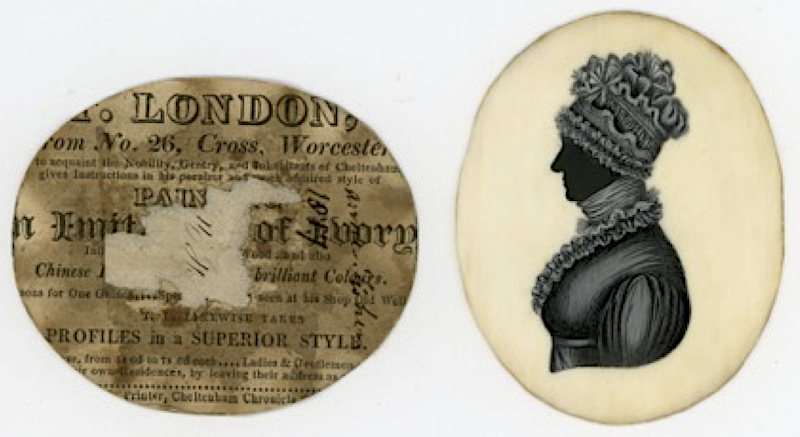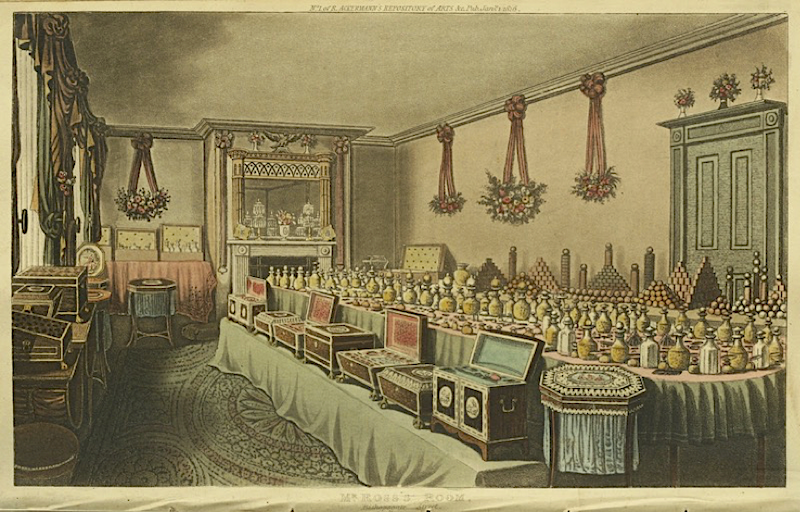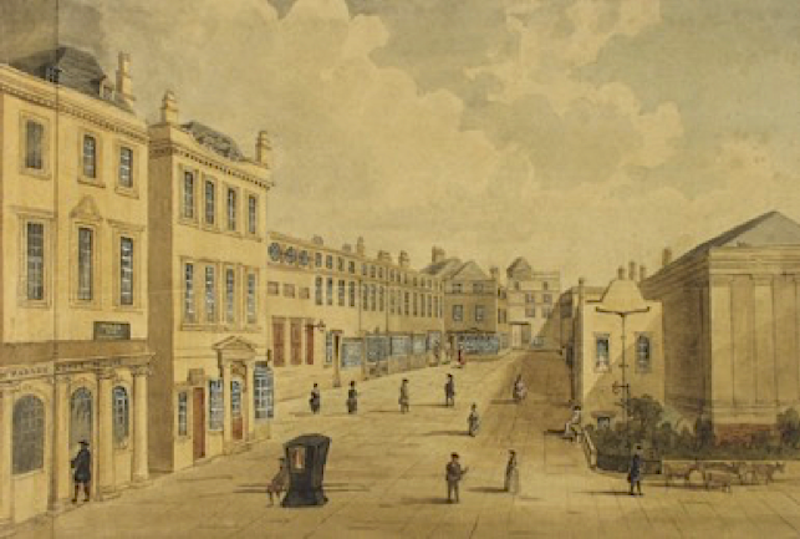London, Thomas (Recent research, April 2022)
THOMAS LONDON (ca.1780 – 1826) PROFILIST, FANCY CABINET PAINTER & TEA DEALER
Previously known only as “T. London”, recent research has revealed new aspects of his life, not least his Christian name! London is known today for profiles painted on ivory. The attire of female sitters was executed with an obvious relish for detail. A small number of duplicate works are also recorded. Both trade labels place him in Worcestershire, first in Kidderminster and then “at his home”, 26 Cross Street, Worcester offering “correct likenesses by his machine on paper and ivory, 6 shillings to 10 shillings”. Although works on paper were advertised, none have so far come to light. No evidence shows him working as a profilist outside the county.
THOMAS LONDON
born ca. 1780 – dec. 05. 09.1826
PARENTS & SIBLINGS
N/K
MARRIAGE
24.07.1803 - St.Nicholas, Worcester
On 22.07.1837 his widow, Fanny London, applied to Doctor Williams’ Library, Red Cross Street, Cripplegate for birth certificates for their son Thomas (born 1809) and their daughter Elizabeth (born 1813). Doctor Williams Library originated as a theological library but then became the registration centre for certification of primarily Protestant Non-Conformists/Dissenters allowed exemption from Established Church baptisms. Son/daughter received certificates 16106 and 16107 respectively. Their birthplace was recorded as 26 Cross Street, Worcester – home of profilist T. London as printed on his second trade label.
Widow London gave her husband’s name as Thomas and his occupation, not as a profilist, but as a ‘fancy cabinet painter’ (see below). Furthermore, she lists her father as George Yarnoll, shoemaker of Worcester. Unfortunately, Thomas’s father and his occupation are unrecorded.
[“fancy cabinet” was a term used to describe light, portable items such as workboxes, dressing cases, portable tables, tea caddies and small cabinets – the like of which Thomas London seemingly embellished.]
SPOUSE
Frances (Fanny) Yarnoll (1776-1868) was baptised 14.08.76 at St. Swithins, Worcester, the second of 12 children born to Sarah and George Yarnoll. Future Directory/Census records always list her as Fanny London.
OFFSPRING
Fanny and Thomas were Non- Conformists. They appear to have had 6 children:
4 were baptised at the Countess of Huntingdon’s Connexion Chapel in Birdport Street, Worcester. The Connexion, broadly Wesleyan in outlook, adhered to Church of England services. Only 2 children survived to adulthood.
* William: presumed born 1804; bur.24.04.05 at St.Oswalds, Worcester
* Elizabeth (1): born 16.1.1806; bapt. 07.02.06 ; bur. 01.10.12 at St. Oswalds, Worcester
* Thomas: born 28.9.1809; bapt. 05.10.09; married 1847; died 1892 at Basford, Notts. No issue
* Mary (1): bapt. 31.10.11; bur. 11.07.13 at Worcester
* Elizabeth (2): born 15.10.13; married 18.12.47; died 1898 at Basford, Notts. No issue
* Mary (2): bapt. 19.08.16; bur. 24.04.32 at Bath.
Fanny and Thomas were Non- Conformists. They appear to have had 6 children:
4 were baptised at the Countess of Huntingdon’s Connexion Chapel in Birdport Street, Worcester. The Connexion, broadly Wesleyan in outlook, adhered to Church of England services. Only 2 children survived to adulthood.
* William: presumed born 1804; bur.24.04.05 at St.Oswalds, Worcester
* Elizabeth (1): born 16.1.1806; bapt. 07.02.06 ; bur. 01.10.12 at St. Oswalds, Worcester
* Thomas: born 28.9.1809; bapt. 05.10.09; married 1847; died 1892 at Basford, Notts. No issue
* Mary (1): bapt. 31.10.11; bur. 11.07.13 at Worcester
* Elizabeth (2): born 15.10.13; married 18.12.47; died 1898 at Basford, Notts. No issue
* Mary (2): bapt. 19.08.16; bur. 24.04.32 at Bath.
Both Thomas Jnr and Elizabeth inherited artistic skills from their father. Thomas is listed as “Drawing Master/Photographer” in various directories/census records up to 1881. Elizabeth is listed as “Miss London, Miniature Painter” in the 1846 Bath Directory and, after marriage, as Elizabeth Raphael “miniature painter” in the 1861-91 Census records. No signed miniatures by Elizabeth London/Raphael have been traced.
PROFILE PAINTING (ca 1798- ca 1817)
London’s earliest trade label has him working from “Mrs. Plater’s, Bullring, Kidderminster”; Pigot’s 1828 Directory lists an Ann Plater there as a “shopkeeper/dealer in sundries”.
Sue McKechnie’s British Silhouette Artists – 1760-1860 (1978) speculated TL’s career spanned about a dozen years and was over about 1810. However, a profile bearing London’s Worcester trade label dated 1817 has since been traced and, seemingly uniquely for a work by London, the named sitter was painted with a bustline termination.

To right, bustline silhouette of woman. To left, London’s Worcester trade label dated 1817. Private Collection
FANCY CABINET PAINTING
The main strand of Thomas London’s career was likely his fancy cabinet painting. How long he and perhaps his family embellished small items of furniture is not known. Nor is it known where the furniture for decoration was supplied from, though a William London, a Freeman of Worcester and of an age to have been TL’s brother, had been apprenticed in 1802 to a John Timmings, Upholsterer/Cabinet Maker of Worcester. It’s possible therefore that he may have been the conduit of supply.
However, the furniture was acquired, it appears to have provided an important source of income for the London family as the 1830/33 Pigot’s Directory lists Fanny London as “Tea Dealer/Fancy Cabinet Maker” and in 1846, the year she retired at the age of 70, The Bath Directory recorded her business as a “Furniture Warehouse”.

Circa 1820, a perfumery showroom display of fancy cabinets inset with medallions of ivory, porcelain, etc, as executed by fancy cabinet painters.
Incidentally, a generation earlier, profilist Francis Torond offered “shades … copied to any size for furniture”. McKechnie speculated that he may have created these for trinket/workboxes/side tables and commodes, i.e., as in ‘fancy’ cabinetware. Certainly, Torond’s Berwick Street address in London’s Soho placed him in the heart of the capital’s furniture trade.
TEA DEALING
No evidence has been found of TL’s circumstances between 1818 and February 1824 when he first advertised his tea business in Bath. Why and when he moved to Bath is unknown and there is no record that he painted any profiles in Bath.
Significantly, The Worcestershire General & Commercial Directory (1820) lists a Thomas Harris – agent to the East India Tea Company living at what was TL’s address, 26 Cross Street, Worcester. Given that TL would later sell East India Company tea in Bath, Harris surely provided the impetus for this new business as well as the source. Also listed at the same address is Thomas Wormington, Law Stationer so it’s possible that by 1820, TL had already moved on, though he is also absent from the 1819 Bath Directory. (Sequential Bath Directories 1820-26 have not yet been accessible to check.)
TL’s first tea advertisement appeared in the BATH CHRONICLE 05.02.1824, headed “AN ADDRESS TO LARGE CONSUMERS OF TEA”, he offered “Strong Congou of Souchong Flavor 6s 6d per lb. … no credit whatever given …. from the East India Warehouses Direct … with company special license and tea brokers’ warrant”. The advert was re-run twice more at fortnightly intervals.
According to the advert, TL’s address was No. 3 (Lower) Walks opposite the Literary Institute - built from the fire damaged shell of the Assembly Rooms in 1820, the Literary Institute had only just opened.

Lower Walks is the terrace set back from the two large buildings on the left.
The building on the right is the Assembly Rooms, prior to its destruction by fire.
TL’s final tea advert in the BATH CHRONICLE 11. 03. 1824. was boldly headed “A CAUTION”. Confusion appears to have arisen between his genuine East India tea and tea being sold by the “London Genuine Tea Company – cheaper than any grocer”. To correct the problem, TL resolved to personally sign his tea packets and “...would scruple not to produce unquestionable documents … showing … his supply IS from the East India Warehouse DIRECT”.
Although no further adverts have been traced, trade must have been steady as Fanny London remained in the business for the next 22 years.
TL also used his tea adverts to promote a “magnificent cabinet of Chinese characters”, possibly painted by himself, that was available at his premises for the public to view, the admission charge being one shilling for two people. Although TL was obviously proud of it, no review can be traced but, given the popularity of tea canisters/teapoys decorated in Chinoiserie style, it’s probable the cabinet decoration was inspired by his own tea business. In the 1837 Bath Directory, his widow advertised the cabinet for sale at £300 (£360,000 in 2020 values) along with a similar piece.
DEATH
Thomas London died 05.09.26, aged 45. His obituary appeared in the BATH CHRONICLE (14 Sept. 1826) - “deeply regretted by all who knew him, Mr. Thos. London of the Lower Walks”.
Fanny London, his widow, died 19.08.1868 aged 93 at 11 Miles Buildings, Bath - the home of her son. TL and Fanny appear to have maintained their non-conformist faith, both being buried, along with daughter Mary, in the Argyll Chapel burying ground, Bathampton, Bath.
Brian Wellings © 2022
